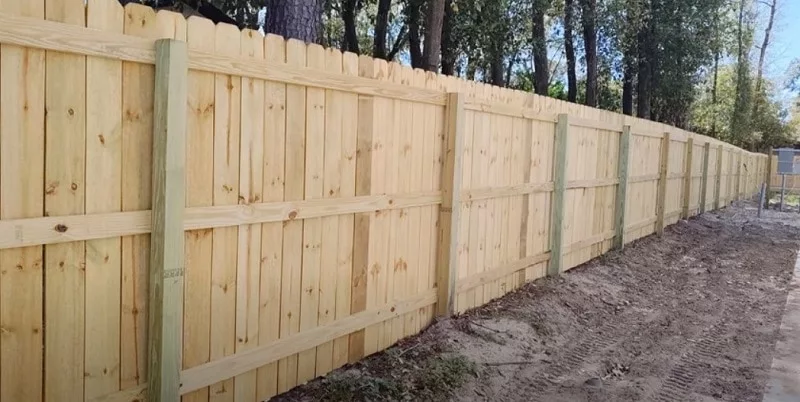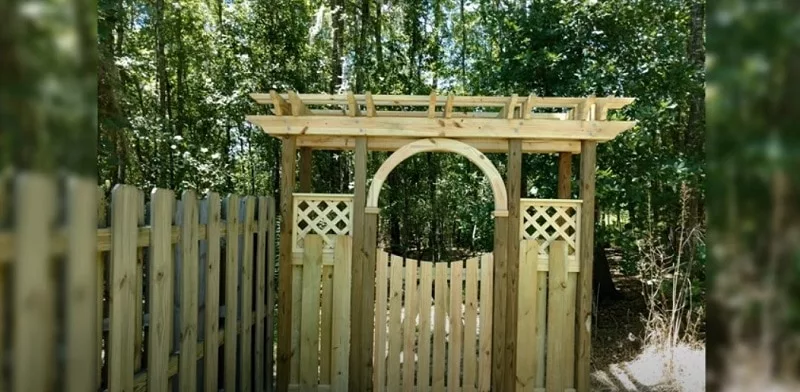Wood is a versatile construction material, and when pressure treated, it can extend the wood’s longevity, adding decades of life to the material. Therefore, any wood for an outdoor project ideally should be pressure-treated; other examples where pressure-treated wood is required include retaining walls, posts buried underground, and when it touches masonry or concrete.
A pressure-treated post will last in concrete for about twenty-five years or more. In addition, the chemical preservatives from the process help timber to withstand moisture and insects. It even protects the wood in severe weather conditions like snow and heavy rain.
This article will examine what you must know once your wood is treated. We will also look at staining pressure-treated wood and analyze the advantages of treated wood over raw wood.
Finally, we will also consider what to do when your pressure-treated wood experiences discoloration and other types of damage.

Table of Contents
Must I Stain Pressure Treated Wood?
Even after the wood is treated, you must still apply a stain or even a water repellent. Pressure treatment involves using chemicals to resist damage, and this process allows the forest industry to use inferior grades of wood.
Unlike high-grade woods from cedar, cypress, and redwood (Sequoioideae), these lesser wood grades are more prone to cracking and splintering, which is why you should apply a stain.
When working with pressure-treated wood, you must allow it to dry completely before applying a stain. This is because this type of material has been injected with lots of chemicals and water, which penetrates the wood completely, making it suitable for ground contact.
Stack wet lumber posts on a level surface like a patio or driveway, give them space for the air to circulate, and check the wood for weight. Check the weight of the wood before and after it dries.
Pressure-treated wood may need several weeks to dry, and when it is dry, it might be too hard for nails to go through. It’s a wise idea to pre-drill holes to prevent splitting the wood.
Metal connectors and constructive adhesives can reduce the number of screws and nails required. Be sure to use coated screws and galvanized nails for assembly. Finally, apply a stain to the “down” side of the wood before nailing it in place.
What Happens If You Don’t Stain Pressure Treated Wood?
Pressure-treated wood needs protection because it’s a porous material, and without a stain or any sealant, dew, moisture, rainwater, and snow can penetrate the material.
As a result, the wood expands until it dries and shrinks again. The constant pattern of expanding and shrinking can cause splits, splinters, cracks, checks, and other blemishes in the wood.
Stains also protect your decking from UV rays and prevent fading, warping, and discoloration.
The visible signs of failing to stain your deck will begin to appear after six months. The effects are aesthetic and include:
- The wood’s color will start to fade, usually from gray to silver.
- The wood will begin checking. This is when small cracks appear slightly scaly. Checking happens when the wood is completely dry, and it can become problematic if this occurs too quickly.
Applying a sealant to your deck helps prevent damage from the elements and resists stains and dirt from settling in. It will also revitalize the Woods’ natural color and allow it to look new.
What Is The Green Color On Pressure Treated Wood?
Copper is the most frequently used element in wood treatment and often creates a green color on the wood.
The green color results from a chemical reaction that occurs between the wood and the preservatives’ components. When the wood dries and reacts to the sun’s UV rays, the green color should disappear.
What Is The Difference Between Pressure Treated And Green Treated?
Green-treated wood is pressure-treated wood that has had preservatives forced into it to protect it against decay. The most popular preservative for wood is ACQ (Alkaline Copper Quaternary).
The copper in that preservative reacts with the sap of the timber and air before oxidizing and creating green dots on the wood’s surface.
It’s not a decorative finish, and you should paint or stain your wood once installed, as shades can differ between batches.

Brown wood (aka cedar tone) may be lumber treated with ACQ with a brown stain or copper Azole.
When buying any pressure-treated lumber, you must understand that they are treated to different degrees of chemical retention. widely-used ratings include “ground,” “below ground,” or “above ground contact.”
Be sure to buy the right kind of lumber for the job and avoid landscape timbers and lumbers stamped as “treated to refusal,” this term doesn’t specify its level of treatment.
Is There Any Difference Between Pressure Treated Wood And Ground Contact Wood?
Pressure-treated wood is usually southern yellow pine that has undergone chemical treatments to prevent decay and rot.
Wood treated to “ground contact” has high chemical retention levels. Therefore, you can place this wood on or in the ground with better resistance to rot or decay.
You must understand the difference between lumber for above-ground use and ground contact-treated wood for an outdoor project.
Factors That Cause Wood To Rot In The Ground
- Constant exposure to Moisture makes the wood rot as the structure breaks down, weakening and increasing its porosity.
- The type of timber, as different woods decompose at different rates. Woods also decay at different rates. Non-treated wood for fence posts won’t last as it can’t withstand biological attack.
Treating Wood For Ground Contact
Chemical preservatives are best at slowing down or preventing the rate of decay on the wood, and they include:
- Creosote
- Pentachlorophenol
- Inorganic arsenic compounds like chromate copper arsenate.
When drying your wood, place the posts in a dry and cool area with plenty of ventilation, and ensure no moisture is present in the wood.
Once your timber is dry, consider the preservative you want to use. Use either creosote, water-borne copper naphthenate, pentachlorophenol, or pressure-treated lumber.
Ensure that the bottom of the post is treated before burying it in the ground, as the part of the buried wood could rot faster than the rest above the ground.
After brushing the timber, wait at least one hour before applying a second coat, and wait for another hour to allow it to soak in.
Continue applying extra coats of preservative on the wood until it stops absorbing. This signifies that the preservative has worked all the way through to the heartwood.
Allow the posts to dry thoroughly; this could take a few months before applying a stain, paint, or a sealant.
If your timber was completely dry before using a preservative, you could apply a sealant immediately.
When Pressure Treated Wood Turns Gray How Long Does It Take?
If you choose to wait before staining your deck, it could take three to six months for your pressure-treated timber to turn gray. Foot traffic, extreme weather conditions, spilled food, or wet leaves can cause discoloration in the wood.
It’s essential to protect your investment and ensure your deck looks its best by finishing it with a stain, paint, or water-repellent sealer.
Treating your decking boards before installation guarantees the longevity of the wood. Pressure-treated timber designed for structural components will withstand the effects of weathering.
Even if it turns gray and minor cracks appear, it shouldn’t diminish the beauty of your deck, as it’s usually hidden from view.
Occasionally chemicals used to treat lumber don’t always soak to the board’s center. Treating the ends will protect them against moisture penetration and secure a longer life for your deck.
Why Is Pressure Treated Wood Cheaper?
Pressure-treated wood is cheaper than redwood, cedar, and other wood species because the pressure-treatment process has allowed the forest industry to use lesser wood grades.
These cheaper woods splinter faster, and after being outside for a year, treated decks can undergo checking. A process where wood dries out too quickly and splits apart due to alternating cycles of wet and dry weather.
The color of the woods fades quicker when exposed to UV rays over prolonged periods. Treated decks can be a bit of a chore, and you will need to apply a penetrating sealer to the timber every year.
Without the right care, your decking will retain blemished and stains from debris and fallen leaves.
This type of wood is treated with toxic chemicals, which can be hazardous to your health if not handled carefully. If the wood is cut, burned, or trimmed, it may release toxic chemicals into the air. It would help if you avoided these woods for gardens.
Disposing of this wood can be difficult. You would need a recycling center that handles this hazardous material and hire a professional to dispose of it safely.
Final Thoughts
Wood is a versatile and invaluable building material, but it’s prone to decay in certain situations, hindering its use for numerous applications.
On the other hand, pressure-treated lumber offers many excellent advantages over natural timber. It is these advantages that make pressure-treated posts last long in concrete.
Recent Posts
Fences are important for keeping our homes safe. They help in preventing the entry of unwanted intruders and thus keeping our house secure. There are different types of fences available in the market...
If you are looking for privacy, then you will get that with vinyl fencing. They come in different styles, colors, heights, and prices making them budget-friendly.